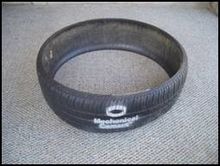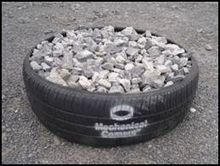- Mechanical Concrete
-
Mechanical Concrete® is the registered trademark name for a confined-aggregate concrete, a simple and economical building material patented in the United States in 2008.
Confined-aggregate concrete is made by using a cylindrical segment to mechanically confine crushed stone or other aggregate materials, creating a cellular, load-supporting unit. Arranged in horizontal or vertical configurations, the units may be combined to form roadway bases, foundations, bearing and retaining walls and other structures.
The technology was invented in 2004 by Samuel G. Bonasso, a professional civil engineer, a former secretary of the West Virginia Department of Transportation and former deputy administrator of the Research and Special Programs Administration and of the Research and Innovative Technology Administration of the U.S. Department of Transportation[1].
Research, laboratory testing and field demonstration beginning in the spring of 2005 led to its acceptance in October 2008 for roadway construction in the state of West Virginia by the West Virginia Department of Transportation[2].
The U.S. Patent and Trademark Office awarded Mechanical Concrete a patent in 2008[3][4] and the technology has since been licensed by Bonasso’s Reinforced Aggregates Co. of Morgantown, W.Va. By mid-2011, the technology had seen success in West Virginia[5], was in use in road construction in commercial and public sector applications in four other states — Arizona, California, Ohio, and Pennsylvania — and had been presented to international audiences[6].
Early manufacturing licensees include Tireland, Inc. of Morgantown, W.Va. and Wyatt's Tire Removal of Wooster, Ohio; early construction projects licensees include Laurita, Inc., of Morgantown, W.Va., GAL Construction, Inc. of Belle Vernon, Pa., and Sundt Construction, Inc. of Tempe, Ariz.
A patent application is pending in Canada.
Contents
Concrete
The Latin roots of the word “concrete” mean “to grow together.”
What is usually called concrete is made by combining a cementing mixture, usually Portland cement, and water with mineral aggregates: sand and gravel. The cement and water undergo a chemical reaction that causes the mixture to harden, or cure; when poured into a form, the chemical reaction binds and integrates the whole into a desired shape.
In Mechanical Concrete, the cylinder, Mechanical Cement®, replaces the cement, water and forms, offering a “mechanical” rather than a “chemical” means of binding aggregates together. It further functions as a lateral reinforcing element and as a stay-in-place forming device. Together, the cylinder and aggregates form a three-dimensional mass capable of supporting and transmitting applied loads.
How Mechanical Concrete is made
In its most general description, Mechanical Concrete is created by taking a sufficiently strong, structural, thin-walled, cylindrical segment made of any tensile material and filling this cylinder with a suitably strong granular aggregate compressive material.
A common, available form of Mechanical Concrete combines a tire-derived cylinder — a used vehicle tire with both sidewalls removed — with crushed limestone or similar natural or recycled aggregate. The cylinder confines and integrates the stone into a functioning, load-supporting unit, analogous to brick or block. It functions as a structural substitute for conventional Portland cement concrete bricks and blocks and for poured-in-place concrete.
Mechanical Concrete elements may be combined in various three-dimensional configurations analogous to large bricks or blocks. To preserve overall structural geometry during stone-filling operations, each cylinder is attached to its adjacent cylinder with a tie, nail or other suitable device. Once the structure is built, the mass and internal friction maintain the structural geometry.
On average, 10 to 12 automobile tires create one cubic yard of Mechanical Concrete and 12,000 tire-derived cylinders create a 12-foot-wide, mile-long lane of roadway and 8000 to cover one acre.
Uses and Applications
Collections of Mechanical Concrete cylindrical units are suitable for use as a roadway base, as a building foundation on most types of soil, as a bearing or retaining wall, as a material for constructing dams and levees and for revetments, fills, storm water retention structures and other bearing-type load-supporting structures in architectural and civil engineering. Collections of Mechanical Concrete cylinders may be stacked into columns in a wide variety of configurations of constant or varying height, width and length.
Because the Mechanical Concrete material is load-bearing and porous and permeable, it can also be used for some types of water drainage and treatment applications.
When made from tire-derived cylinders, Mechanical Concrete is a highly energy-absorbing material, due to the partial fluid properties of the stone aggregate and the elasticity of the tire tread cylinder. This energy-absorbing characteristic suggests its use as highway crash barriers for both low-speed and high-speed situations. It also suggests its use as a base isolation material in some earthquake prone regions. It can provide an inexpensive base-isolation alternative for new and retrofit mobile home and residential foundations; in addition, it offers a new material for a rational design approach to larger base isolation structures.
Since 2006, it has been used to build public access and private industrial road bases in California, Arizona, West Virginia, Ohio, and Pennsylvania.
Because of its simplicity and ease of construction, Mechanical Concrete can assist developing regions globally in building and maintaining low-cost, reliable, all-season farm-to-market rural roads with local labor, materials and equipment.
Mechanical Concrete was exhibited at the 10th International Conference on Low-Volume Roads hosted in July 2011 by the Transportation Research Board of the National Academies.
Benefits
Mechanical Concrete is simple. Using Mechanical Concrete methods, general, unskilled construction laborers can transform stone aggregates and other indigenous earthen materials into new, functioning solid building materials faster than using conventional materials, means and methods. Strong, resilient, permeable unpaved roadways, retaining and bearing walls, and foundations may be constructed with minimal training and little supporting industrial infrastructure and with limited supervision.
Mechanical Concrete is strong. A tire-derived cylinder filled with crushed limestone or similar aggregate produces 200 pounds per square inch (14.4 tons per square foot) working-strength material. Tractor-trailer trucks at maximum legal weight generate 100 pounds per square inch of vertical pressure.
Mechanical Concrete is economical. Costs are less by 25 to 50 percent compared with reinforced concrete or masonry construction for a variety of reasons. First, most reinforced concrete and masonry structures are inherently over-designed to resist the bearing-type stresses generated by the loads supported. Although Mechanical Concrete is over-designed, it operates much closer to the bearing stress range generated by the loads being supported so it is more economical. In addition, a Mechanical Concrete structure is manufactured at the construction site and ready to resist loads as soon as it is placed — no setting or curing time is required. To create and build these structures consumes less net energy than comparable construction methods.
In addition, Mechanical Concrete, when constructed using tire-derived cylinders, offers a solution to a major global environmental waste problem. Each year, the United States generates about 300 million waste automobile tires – roughly one tire per person per year[7]. As of 2007, about 90 percent of used tires found some end use, mostly as tire-derived fuel used for power generation. Still, some 128 million waste tires were stacked high in unhealthy and dangerous piles across the nation[8]. Burying tire-derived material is a method environmental agencies prefer for using and disposing of waste tires[9]. In the U.S. Environmental Protection Agency’s formal hierarchy of solid waste management, re-use delivers greater environmental benefit than recycling[10].
External Links
References
- ^ Pam Kasey (2006-06-08). "Bonasso Devises New Use for Old Tires". The State Journal. http://www.statejournal.com/story.cfm?func=viewstory&storyid=11463.
- ^ West Virginia Department of Transportation approval letter, Oct. 2008.
- ^ US patent 7470092, Samuel G. Bonasso, "System and method for reinforcing aggregate particles, and structures resulting therefrom", issued 2008-12-30
- ^ Pam Kasey (2009-01-15). "W.Va. Engineer Patents Way to Reuse Old Tires". The State Journal. http://www.statejournal.com/story.cfm?func=viewstory&storyid=50046.
- ^ Pam Kasey (2010-12-21). "Road Technology Finds Use in Marcellus Fields". The State Journal. http://www.statejournal.com/story.cfm?func=viewstory&storyid=91393.
- ^ Dana Arquilla (2011-08-12). "Mechanical Concrete Concept May Go International". WBOY.com. http://wboy.com/story.cfm?func=viewstory&storyid=105240.
- ^ Final Rulemaking: Identification of Nonhazardous Secondary Materials That Are Solid Waste: Scrap Tires. U.S. Environmental Protection Agency, Feb. 2011.
- ^ More Old Tires Put to New Uses; Scrap Tire Piles Receding. Rubber Manufacturers' Association, June 2009.
- ^ Scrap Tires: Civil Engineering Uses. U.S. Environmental Protection Agency, accessed August 20, 2011.
- ^ Non-Hazardous Waste Management Hierarchy. U.S. Environmental Protection Agency, accessed August 20, 2011.
Categories:- Civil engineering
- Building materials
- Road construction
- Road infrastructure
Wikimedia Foundation. 2010.



